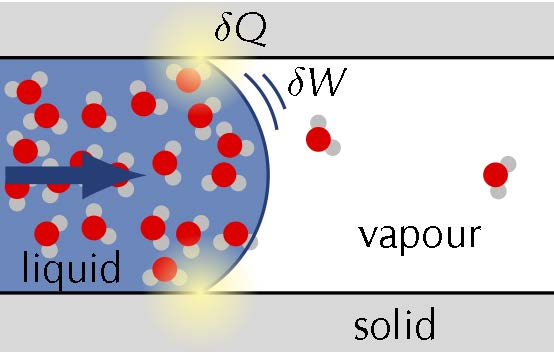- Share
- Share on Facebook
- Share on X
- Share on LinkedIn
Recruitment

PhD offer 2025-2028 - ANR project HTD-PoM
Supervisors: Cyril Picard and Romain Lhermerout
Project description
Confined water is ubiquitous in nature. It plays a crucial role in biochemical processes that sustain life but also in various nanoscale phenomena which are fundamental for tackling pressing societal challenges, such as ensuring a sustainable supply of drinking water and achieving decarbonization of our energy sources [1].
In this context, this PhD project, which is funded by the French Brazilians ANR project HTD-PoM, aims to explore thermomechanical phenomena subsequent to the confinement of aqueous solutions within hydrophobic nanopores.
The experimental approach will leverage porous fluids made of ordered hydrophobic nanoporous particles (see Fig.1) immersed in water or aqueous solution and dynamical calo-porosimetry measurements using an innovative apparatus recently developed at LIPhy [2]. This instrument enables the characterization of forced filling under pressure of the hydrophobic nanoporous particles, as well as their spontaneous drying when the pressure is released. This PhD work will open a new route to shed light on thermal effects related to wetting and drying under confinement [3].
Rapid calorimetric measurements will enable the determination of the heat released during particle filling playing with different solutions and nanoporous materials. It will also give access to the thermoelastic properties of the confined liquids and the heat conductivity of the nanoporous particle according to their empty or filled state. As predicted from our recent numerical simulations [3], interfaces play a key role at these nanometric scale and may lead to surprising behaviours such as a decrease of the heat conductivity of particles when they are filled with water. This thesis will be carried out jointly with numerical works in the framework of the HTD-PoM project and will also contribute to an applied project in the lab dedicated to a breakthrough approach for the recovery of osmotic energy [4] funded by an industrial contract.
Profile
Candidates should have a strong background in physics, soft matter and thermodynamics as well as a good interest in physico-chemistry. More generally the candidate should feel at ease with interdisciplinarity and motivated by instrumentation and experimental challenges!
Application
Please submit by email a curriculum vitae mentioning at least 2 referees and a cover letter.
You will be contacted by email if your skills and experience match the profile.
References
[1] B. E. Logan and M. Elimelech. Membrane-based processes for sustainable power generation using water. Nature, 488.7411 (2012)
[2] L. Michel et al. A Dynamical calo-porosimeter to characterize wetting and drying processes in lyophobic nanometric pores, Rev. Sci.
Instrum. 95.10 (2024)
[3] N. Ferreira de Souza et al. Thermal Conductivity of a Fluid-Filled Nanoporous Material: Underlying Molecular Mechanisms and the Rattle Effect, The Journal of Physical Chemistry B, 128.10 (2024)
[4] C. Picard, E. Charlaix, and W. Chèvremont. Procédé de conversion d’énergie osmotique en énergie hydraulique et de dessalement,
WO2022/258912.
Download
calo-liphy.pdf (PDF, 362.03 KB)
Contact
Cyril PICARD
MODI team
cyril.picard univ-grenoble-alpes.fr (cyril[dot]picard[at]univ-grenoble-alpes[dot]fr)
univ-grenoble-alpes.fr (cyril[dot]picard[at]univ-grenoble-alpes[dot]fr)
Romain LHERMEROUT
MODI team
romain.lhermerout univ-grenoble-alpes.fr (romain[dot]lhermerout[at]univ-grenoble-alpes[dot]fr)
univ-grenoble-alpes.fr (romain[dot]lhermerout[at]univ-grenoble-alpes[dot]fr)
- Share
- Share on Facebook
- Share on X
- Share on LinkedIn